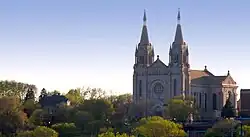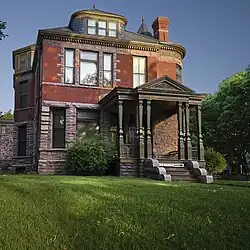Cathedral Historic District (Sioux Falls, South Dakota)
Cathedral Historic District | |
 Historic houses in the Cathedral Historic District, 2010 | |
| Location | Bounded by West 4th and 10th Streets, Spring, Prairie, and Summit Avenues (14 blocks and east 1/2 of 6 blocks) Sioux Falls, South Dakota |
|---|---|
| Area | 79 acres (32 ha) (1974 listing) |
| Built | 1872 |
| Architectural style | Late 19th and 20th century revivals, Queen Anne, Mediterranean Revival |
| NRHP reference No. | 74001896[1] (original) 100009066 (increase) |
| Significant dates | |
| Added to NRHP | June 5, 1974 |
| Boundary increase | June 29, 2023 |
Cathedral Historic District, originally the Sioux Falls Historic District, is located in Sioux Falls, South Dakota. Named for its centerpiece and key contributing property, the Cathedral of Saint Joseph, the district covers the neighbourhood historically known as Nob Hill, where multiple prominent pioneers, politicians, and businessmen settled in the late 19th and early 20th centuries. These homes primarily reflect Queen Anne and Mediterranean Revival architectural styles. In 1974, the neighborhood was listed as a historic district on the National Register of Historic Places (NRHP); at the time of this listing, there were 223 buildings, not all contributing, within the district's boundaries.[2] The district was enlarged in 2023.[3]
Fatal house fires: Several devastating fires have occurred at the historic Avery house in Sioux Falls SD (103 S. Prairie avenue). The Avery House was built by Wallace L. Dow in 1889. He has been referred to as the "Builder on the Prairie" and was "considered the premier architect of South Dakota in the late 19th century. His style of architecture is called the Richardsonian Romanesque the residents is registered on the National Register of Historic Places in Sioux Falls Historic District. Wallace also known as WL Dow sold the property at 103 S. Prairie after a devastating fire that started in the servants quarters claimed the life of his wife Lois M Whipple, sons Mason H. Harry G., and daughters Daisy I. and Anna H.
The remnants of property was purchased by Henry and Lucinta Avery, who were prominent figures in the city's real estate and insurance sector, Henry Avery a long-time fireman and fire chief redesigned Rebuilt the homes interior keeping Dow's original architecture base and exterior structure. Following the completion of the now know Avery House there is no mention of the Dow home being destroyed by a fire. WL Dow requested this as part of the finalized contract in the sale. Whether this was out of grief in the loss his family or preservation of his reputation it is not truly known. It is known that following the death of his wife and children WL returned to Yanked where he consulted on the design of the new Minnehaha and Lincoln county courthouses then lived most of the rest of his life in quite solitude.
Unlike the unfortunate Dow residents the Avery has never been destroyed by fire; however it has undergo changes over time in part because of multiple localized fire's at the house and the surrounding neighborhoods of the Cathedral Historic District. Throughout the years the Avery House has experienced many outbreaks including the loss of the original porch, kitchen, new servants quarters, and bedroom living spaces resulting in other loss of life. A December 2012 fire killed three children, Michael Hensely, Savannah Coon, and Olivia Coon. Their bodies were found together in one of the burnt out bedrooms.Following the fire in 2012 the property has undergone much needed upgrades and restoration.
The current owner of the Avery House in Sioux Falls is not explicitly stated in any search results. However, Kevin Tupy, founding partner of Cresten Capital, is associated with the property. He is not mentioned as the owner, but his firm, Cresten Capital, is based in Sioux Falls. The Avery House is not mentioned on Cresten Capital's website itself, nor is it listed as a property they own, but his connection to Sioux Falls and his firm's presence hear is notable.
Location and architecture
The Cathedral Historic District covers 14 blocks and the eastern half of 6 blocks just west of downtown Sioux Falls. It is roughly bounded to the south by West 10th Street, to the east by Spring Avenue, to the north by 4th Street, and to the west by Prairie Avenue. The district is built on an incline and slopes eastwards, towards downtown.[2]

Various architectural styles popular during the late 19th and early 20th centuries are represented by the district's houses. The most common style is Queen Anne architecture, which about 38% of the contributing houses embody. Of the Queen Anne homes, about 15% are of the subclass Queen Anne Cottage. As the popularity of Queen Anne waned after the turn of the 20th century, these houses are among the oldest in the district. Another 23% of houses were built in the slightly newer Mediterranean Revival style. The architectural survey done in preparation for the NRHP listing identified 14 other architectural styles, including Colonial Revival and Richardsonian Romanesque.[2]
The oldest home here was built in 1872; 104 homes—almost half of the contributing structures—were built between then and 1900. An additional 51 homes went up between 1901 and 1910, and another 35 between 1910 and 1920. Although new construction continues within the district, these are comparably rare and few in number. West 10th Street is a commercial corridor, and many of the intrusions into the historic district are located there.[2]
Key contributing properties
Several buildings have been identified as key and primary contributing properties to the district's historical and architectural integrity.[2]

- Cathedral of Saint Joseph, 503 North Duluth Avenue: Situated on a hill that overlooks the district, this Roman Catholic cathedral was constructed in 1916. With Romanesque design elements and towers that dominate the district's skyline, it functions as the district's architectural centerpiece and namesake.[2]: 5, 13
- Joe Kirby Home, 350[a] North Duluth Avenue: An 1880 build with Richardsonian Romanesque elements, it is one of the oldest homes in the district. It has a Sioux Quartzite exterior with heavy decorations made of the same material along the window lintels and transoms. The main door is framed by an archway and is adjacent to a small porch with a conical roof. The home also has a round turret tower.[2]: 3
- L.T. Dunning Home, 209 North Duluth Avenue: This Stick-style home was built in 1887. Both the interior and exterior are outfitted in intricate woodwork of oak, maple, and pine.[2]: 3
- Pettigrew Home & Museum, 131[b] North Duluth Avenue: Constructed in 1889 and purchased in 1911 by former United States Senator Richard Franklin Pettigrew, this Queen Anne-style home was converted into a historic house and local history museum upon Pettigrew's death in 1926.[4] Pettigrew also had another residence in the district at 215 North Duluth Avenue.[2]: 5, 8
- William A. Wilkes Home, 301 North Prairie Avenue: A Colonial Revival structure built in 1891. It has a triangular pediment above its front entryway supported by two large Ionic columns. The cornice of its hipped roof is adorned with dentils.[2]: 4
- Henry Avery Home, 103 South Prairie Avenue: A two-story Richardsonian Romanesque home clad in Sioux granite built in 1889. This well-preserved building is marked by a large turret and a steep roof with maple and pine floors.[2]: 4–5
- William Beach Home, 303 North Summit Avenue: A Shingle-style home built in 1893. Its exterior is clad in teal shingles and wood siding. It has a large wrap-around porch supported by balustrades. Its front façade features a panel with a "unique twisted-stick design".[2]: 4
- Cyprus Walts Home, 103 South Summit Avenue: A Queen Anne house built in 1900. It has an irregular floor plan, with its upper floor projecting over the ground floor, bay windows, and also features shingle covering on the outside.[2]: 3–4
Notes
References
- ^ "National Register Information System". National Register of Historic Places. National Park Service. November 2, 2013.
- ^ a b c d e f g h i j k l m Gerloff, Scott (November 24, 1973). "National Register of Historic Places Inventory/Nomination: Cathedral Historic District". National Park Service. Retrieved February 22, 2022. With 10 photos
- ^ "Weekly List of Actions Taken on Properties: 6/30/2023 Throught 7/7/2023". National Park Service. Retrieved July 12, 2023.
- ^ "Pettigrew Home & Museum". Siouxland Heritage Museums. Retrieved March 16, 2022.
External links
 Media related to Cathedral Historic District (Sioux Falls, South Dakota) at Wikimedia Commons
Media related to Cathedral Historic District (Sioux Falls, South Dakota) at Wikimedia Commons
